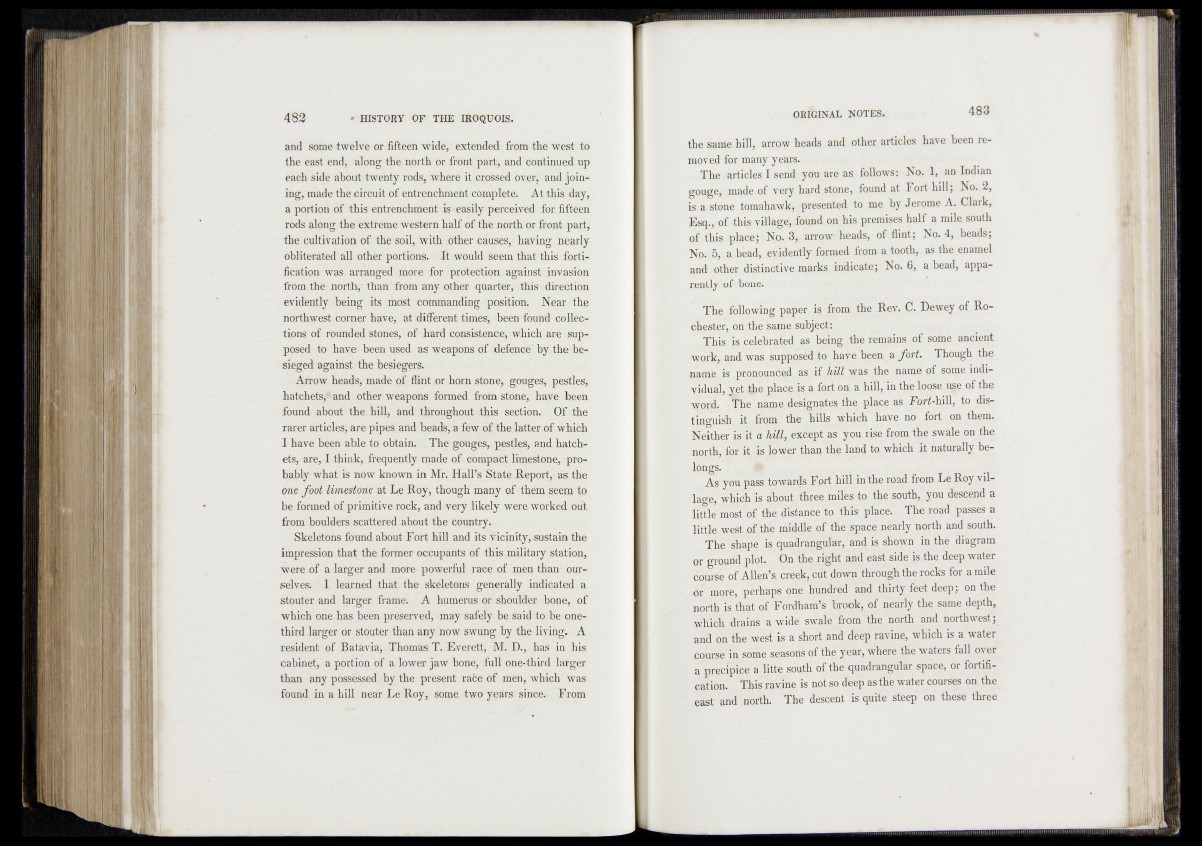
and* some twelve or fifteen wide, extended from the West to
the east end, 'along the north or -front part, and continued up
each side about<twenty rods, where it crossed ovefc,: and joining,
made the.circuit .of entrenchment complete. At this -day,
a portion of this entrenchment is easily perceived for fifteen
rods along the extreme western half of the north or front part,
the cultivation of the soil, with vother causes, jhaving nearly
obliterated all other portions. It would seem that this fortification
was arranged -more ■ for protection agamStHrnvasi'on
from the north, than from any other quarter, this x,direction
evidently being Y its most commanding position, ,-Near Ahp
northwest corner have*' at different tirfies; -been found - collection
of rounded stones, of - hard consistence, which are supposed
to have been used as weapons o f defence"by the^be-
sieged against the besiegers;
Arrow beads-, made of flint or horn stone, gouges,- pjegtles,
hatchets/* and other weapons formed from .stone, hare bee»
found about the.hill, and throughout this section. Of the,
rarer articles, are-pipes arid beads* a few.qf the latter, of which
I have been able to obtain. ; The gduges,« pestles, and, hatchets,
arey I think, frequently made of- compact limestone, probably
whatisTiowknQwn iir Mr. Halite State Report, assthe
me fo o t limestone at Le Roy, though many of tliemseem to
be formed of primitive rook, and very likely were forked out
from boulders’seattered about the Countryv
Skeletons found about Fort hill and «its wicinity,-ajstain the
impression that the former occupants of this military station,
were of a larger and more powerful race of men. than - our--
selves. I learned that the skeletons generally indicated a
stouter and larger frame. A hunaerus Or shoulder bone, of
which one has been preserved, -may safely be said to be one-
third larger or stouter than any now swung by the living.. A
resident of Batavia, Thomas T. Everett, M. I).,: has in his
cabinet, a portion of a lower jaw bone, full one-third larger
than any possessed; by the pr-esent/race of men, which was
found in a hill hear Le Roy, some two years since./ From
the samp hill, arrow heads and other articles have been removed
for many years.
• The . articles I send you are as follows; No. 1, an Indian
,jn»ade of very hard stone, found; at Eort hill; No. 2,
is. ^Mone, tomahawk,*, presented to me by Jerome A. Clark,
Esq., of, this village, found on bis premises hqlf a mile south
of this .place;' ISb, 3* arrow- heads, of flint; No. 4, beads;
Nb4#,^-beadi, evidently formed- from a tooth, as the enamel
and other -distinctive marks indicate; No. 6, a bead, apparently
of-bone.
The following paper i§ from the Rev. C. Dewey of Rochester,
on the same subject:
This is celebrated as, being the remains of some ancient
work, ^nd was supposed have beena fort. Though the
nape js pronounced as if. hill w«j.s the name of some indi-
yidudl, vet $ae place is a fort on a hill, in the loose n§e of the
word. -The name designates the place as fort-hill, to dis-
tmguish it from the hills which have no fort on them..
Neither is it a hill, except as you rise from the swale on the
north,'for"it-,is lower than the land to which it naturally belongs.
Y .■§- - , jS( . t yir - :
As you pass towards Fprt hill in the road from Le Roy village,
which is about/three miles to the south, you descend a
Little most of the>distance to this place. The road passes a
little west of the middle of the space nearly north and south.
The sbaip is quadrangular, and is shown in the diagram
or grouricl plot. ‘ On the right and east side is the deep water
cofiriJe of Allen’s creek, cut down through the rocks for a mile
-hr more, perhaps one hundred and thirty feet deep; on the
north is that of Fordham’s brook, of nearly the same depth,
which drains a wide swale from -the north and northwest;
and op' the weft is a short and deep ravine, which is a 'water
course in some seasons of the year, where the waters fall over
a precipice a lifte south of the quadrangular space, or fortification.
' This ravine is not.so deep as the water courses on the
east arid north. The descent is quite steep on these three